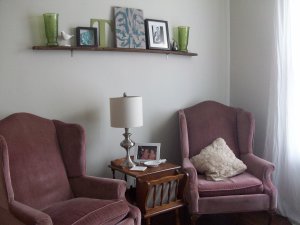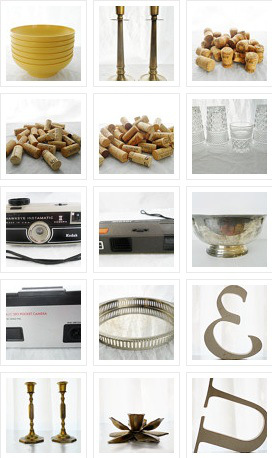This:
Plus this:
Equals durable, custom-colored upholstery fabric for less than five dollars per yard. Can’t beat that deal with a stick.
Dying dropcloths, or any fabric, is super easy. Just follow the package directions. Here’s my much less concise version:
- Fill your washing machine with hot water
- Add dye, let it swish around in there for a while to mix
- Add your wet, unfolded fabric to the mix (after repeating this process several times, I started skipping the pre-wetting altogether and never looked back)
- Reset the machine to the beginning of the wash cycle and let it swish around for a while
- Stop the machine before it starts spinning/draining and check to see how your fabric is looking. If you’re not sure it’d dark enough let it sit in the water a while longer. Set a timer so you don’t forget it.
- Let the machine drain and make sure the rinse cycle is set to cold. Check as it’s rinsing to see if there’s a lot of dye in the water. You may need to run in through the rinse cycle again until the water is clear.
- Wash in hot water with detergent
- Pop your fabric in the dryer and run an empty load through the washing machine with hot water and detergent, and maybe even bleach. I was out of bleach so I didn’t use any and it turned out okay.
Lucky for me I’ve got an old-school top-loading machine. I yearn for a sleek and efficient front-loader but in this case I was grateful for the ability to pull the fabric out and check it before letting all the dye go down the drain.
But alas, getting the perfect shade was not as easy as I had originally planned. I was going for a nice, deep charcoal gray. I figured it wouldn’t look too matchy-matchy with my oatmeal-colored sofa and would maybe do a good job of hiding stains and cat hair. The only grayish options at Hobby Lobby were Pearl Gray, which looked a little pale to me, and black. I opted for the black, figuring I’d only use half the bottle and end up with gray. Sounds great, right? Not so much. This is what I ended up with:
Lavender! Lovely plant, terrible upholstery color. Turns out the black had a purple base, so weakening it gave me pastel purple instead of the moody gray I was going for. Total bummer. I thought and thought about what to do next. I really wanted my gray to have more of a blue undertone. In a stroke of genius I got out my acrylic paints and whipped up a shade of lavender, then added some navy blue to see what would happen. Voila! A lovely greige. Off to Hobby Lobby I went for some navy blue dye, and after repeating the steps above with lavender fabric + blue dye I had this…
Darker purple dropcloths. Terrible. I was starting to worry I’d have to toss these dropcloths and start over with fresh ones, but giving up isn’t really my style so I persevered. I did some googling, consulted Rit’s own guide for creating custom colors (which I should have done in the first place) and decided, prepare yourselves people, to try dying them orange.
One package of sunshine orange dye later I had this:
I’m not gonna act like there’s not a tiny bit of lavender in there, because there totally is. But the orange cancelled out most of the purple and while it’s not my dream gray, I’m totally okay with it. I even think it’s a nice, warm contrast to the cooler, more greeny blueish gray on the wall behind it. And now that I’ve got that mauve fabric outta there, I’m loving it even more. Here’s a sneak peak midway through the reupholstery process, to give you an idea of how the fabric looks in action:
Lookin good, huh? Now here’s the bad news: I really underestimated how much fabric I would need. Poor judgement combined with significant shrinkage from all that washing and drying means that my three 5×7 dropcloths (which each shrunk to about 4×4) were only enough to cover one chair. Now I’ve gotta pick up some more dropcloths and try to retrace my footsteps in creating an identical (or very close) shade of gray.
So, on the agenda for after work today:
- go to Lowe’s for more dropcloths and more staples (I’m out)
- grab some more dye from Hobby Lobby
- dye my new dropcloths, try to recreate my genius
- finish stapling up chair #1
And the rest of this week:
- teach myself how to sew a box cushion for chair #1
- cut fabric for, reupholster, and sew box cushion for chair #2
I’m exhausted just thinking about it. I’m so glad I tore chair #2 apart before I could talk myself out of it, because I would totally just leave it mauve for another six months or so at this point.
Posted in Living Room, Projects


